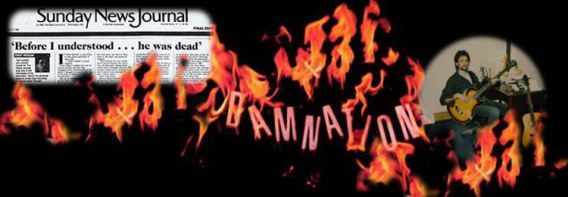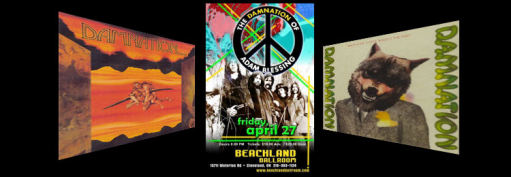|
 |
Why the "Real Story"
Why a "real" story about the Damnation of Adam Blessing? For the
benefit of the handful of people, who over the years have gone online
to "search" the above. Apparently, there are actually people out there
who are still able to recognize art when they see it, and in fact seek
out obscure music, films, etc. Unlike the vast majority of society that
seems to believe that the only things of value are that which corporate
America insists you must have. (Commercial success equates to artist
merit). Can you imagine if there had been "American Idol" back in the
day? I wonder how Simon would have liked Bob Dylan or Janis Joplin?
In addition to my vivid recollections I call "Damnation moments"- what
it was like for me growing up in a band that was not only signed to a
major label, but opened shows for the likes of Eric Clapton, Janis
Joplin, Alice Cooper, Grand Funk, Ten Years After, and Traffic- just to
name a few. Read on and View photos
from the last gig The Damnation of Adam Blessing would ever play,
(September 29, 2000), plus a few shots from the Rock N' Roll Hall of
Fame gig, (September 27, 2000), and the first promo picture of the band
after signing to UA. (1969)
|
|
|
Illusions of Justice
|

|
When I was 18 years old I recorded my first album with the Damnation of
Adam Blessing, for United Artist records. From 1969 to 1973 the group
would record four albums in all. Being a part of the Cleveland music
scene in the late 60's and early 70's when groups like the James Gang,
Eric Carmen of the Raspberries, Benjamin Orr, later of the Cars, were
all local artists, provided an incredibly fertile environment in which
a young band could develop. For several years Damnation's records were
regionally successful, with their singles and albums often going top 5
in Cleveland, and other parts of the mid-west. The major hindrance that
kept the group from breaking nationally was a distribution problem with
United Artists. Read on...
|



|
|
|
|
Abyss of Infamy
|

|
by Ray Benich, with an Introduction by Dr. Mike Skladany
When
"Illusions of Justice" is released, the book will come with an audio
CD. The CD will include a song written about a particular incident
described in each chapter. Abyss of Infamy, is from chapter VI. On this
version of Abyss we feature another incredible young guitarist. Twenty
two year old Jeff White contributes an emotionally charged lead that's
indicative of the angst subject matter of the song. The rap at the end
of the song is deftly laid down here by Raz D, III playing the part of
Pennell from hell, as he pleads: Don't look for me, I'm at the bottom
of a sea. The gnashing of teeth, tormented by the beast, the gnashing
of teeth, tormented by the beast, it's a Mother F#@*$! Don't look for
me! Don't look for me!
Our current morbid fascination with
serial killers and other horrific assailants reveal sick minds and an
even sicker society at work. Hyper media attention to the latest
kill-spree -- all spells out-- a society that has simply lost its soul.
Where is the humanity, decency, and respect for others in all this???
An answer of sorts is forthcoming...
Abyss of Infamy uses rock
n' roll to send what I believe to be a socially relevant message. Abyss
is based on my personal observations, made while having been housed
with a number of men in prison awaiting the death penalty, (there is no
"death row" in the state of Delaware), in particular serial killer
Stephen Pennell. What these men would confide in a fellow "lifer" and
what they'd tell a clinical researcher are two different things.
The
song exposes the way in which many psychopathic killers are actually
gratified by, and inspired by, seeing stories about their crimes in the
news papers and on TV. In the song they're referred to as "media
clones". That is to say that the media itself actually inspires and
encourages these sick individuals to seek recognition through their
horrific acts. Perhaps federal legislation should be introduced
mandating limitations on the air time given to assailants. Sometimes,
all an unstable mind, teetering on the brink of a violent rampage
needs, is that final push that the media gives, when they do one of
their infamous, grandiose, in depth glorification's of some horrific
act. Spending more time on the shooter, than the innocent victims,
giving birth to yet one more, media clone.
Read More...
|



|
|
|
|
Reunion
|

|
Damnation's focus was obviously on contemporary hard rock, but the
arrangements were far more advanced. While most heavy rock acts
featured screaming or shouting vocalists, Damnation tested the waters
with low-range, gospel-like harmonies and Adam Blessing's grinding yet
melodic leads. Songs would quickly shift from simple rock arrangements
into idiosyncratic middle-eights - sometimes over a pounding rhythm by
drummer Bill Schwark and bassist Ray Benich, sometimes enhancing a
ballad.
And when it came to hooks, Damnation could lure in the listener almost
every time. And yet, outside of their four albums and a brief
appearance in a Rock & Roll Hall of Fame exhibit on Cleveland
bands, little evidence remains. As literally hundreds of inferior
contemporaries have seen their albums reissued on CD, not a single note
of Damnation music has entered the digital realm until now. (Excerpt
written by Mr. Doug Sheppard courtesy of Ugly Things Magazine Issue
..17) For the full 18-page history on the Damnation of Adam Blessing
order you copy online at Ugly-Things Magazine
|

|
|
|
|